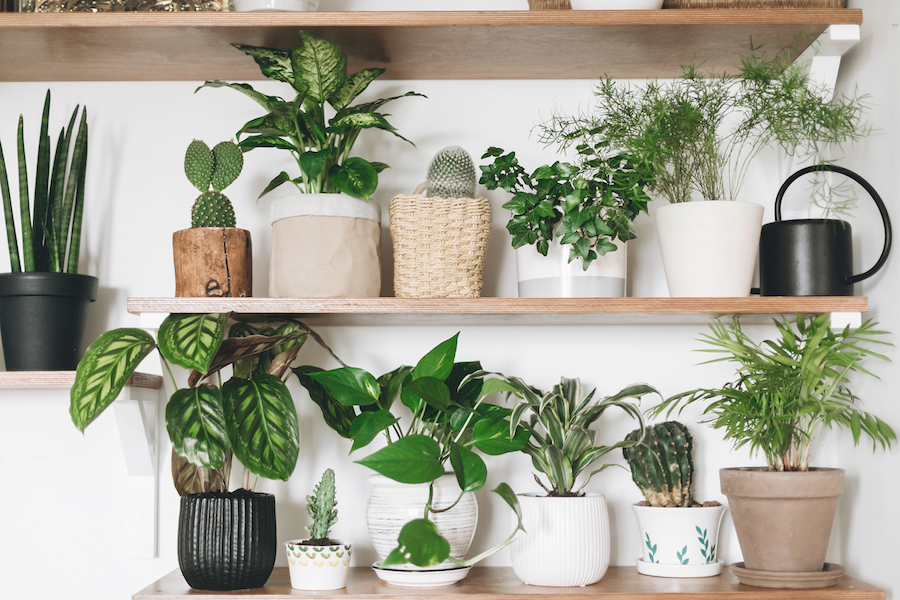Houseplants looking tired? They may need repotting…
Houseplant expert Claire Bishop offers a step-by-step guide on how to boost your houseplants by repotting them.
As summer fades to autumn, you may be wanting to green up your inside space – and you can start by repotting your houseplants to give them a boost before the cooler weather sets in.
Claire Bishop, houseplant buyer for Dobbies Garden Centres (dobbies.com), who is championing the #KeepBritainGrowing campaign by the Horticultural Trades Association, says all your indoor plants will need regular repotting.

Boost your houseplants by repotting them annually
“Whether you have an air purifying sansevieria on your bedside table, or your own indoor jungle with plants trailing over shelves and bold leafy greens taking pride of place in every room, even the lowest maintenance plants require a repot – either annually or at least every two years – to keep them looking their best for years to come,” she explains.
Here she answers all our questions about repotting.
How do you know if your houseplant needs repotting?

Overcrowded roots are a clue
“If the plant simply looks like it is too big for its pot, it may be time,” Bishop explains. “As a general rule of thumb, it is best to gradually increase pot sizes, so doing this as an annual job will encourage steady growth.”
Other telltale signs are when the roots are growing out of the drainage holes, water is sitting on the top and not absorbing, the soil is dried out or looks like it is disintegrating, or simply that it has been years since you repotted it.
So, how do you repot a plant?
Bishop offers the following step-by-step guide:
1. Remove plant from current pot

Turn your new plant sideways, hold it gently by the stems or leaves, and tap the bottom of its current pot until the plant slides out. You might need to give it a bit of help with a couple of gentle tugs on the base of the stems.
2. Loosen the roots

Loosen the roots and some of the old soil will drop off
Loosen the plant’s roots gently with your hands. You can prune off any threadlike roots that are extra-long, just make sure to leave the thicker roots at the base of the foliage.
If your plant is root bound – the roots are growing in very tight circles around the base of the plant – unbind the roots as best you can and give them a trim. For plants that are rootbound, make sure the new container is roughly 2 to 4 inches bigger in diameter, so it has space for new root growth.
3. Remove old potting mix
Remove about one third or more of the potting mix surrounding the plant. As it grew, your plant removed some of the nutrients in the current mix, so you will want to give it fresh mix if you are potting it anyway.
4. Add new potting mix

Make sure you have adequate drainage material in the bottom of the pot
Pour a layer of fresh potting soil into the new planter and pack it down, removing any air pockets. If your new planter doesn’t have a drainage hole, layer the bottom grit or similar drainage material before adding the potting mix. The goal is to create crevices for the extra water to pool into, away from your plant’s roots.
5. Carefully replace the plant
Set the plant that you removed from the pot on top of the fresh layer of mix in the new planter, making sure it’s sitting in the centre, then add potting mix around the plant until it is secure. Be sure not to pack too much soil into the planter, as you want the roots to be able to breathe.
6. Water and enjoy

Water your newly repotted plant
Even out the potting soil on top, water well, and enjoy watching your houseplant grow and thrive in its roomier container.
Are all houseplants easy to repot?
“There aren’t any plants that are difficult to repot other than cacti but that’s mainly due to the spines, so wear thick gloves when repotting them,” Bishop advises. Plants which are easy to repot include the peace lily (spathiphyllum), cheese plant (monstera), prayer plant (calathea) and snake plant (sansevieria).
How can I prevent transplant shock when I repot?

To avoid transplant shock, place plants back in their original spot
Plants can suffer from transplant shock after repotting which can kill the plant, but there are ways to deal with this, Bishop says.
Firstly, make sure the new pot has sufficient drainage holes, then place the plant in exactly the same spot it used to inhabit, so that it gets the same temperature and light conditions it had before.
Give the plant a dose of water-soluble, all-purpose plant food and nip off all dead leaves and stem ends to make room for new parts to grow.
The Press Association
Latest posts by The Press Association (see all)
- 3 easy Mary Berry recipes to make this season - November 22, 2024
- In Pictures: Party stalwart kept New Labour in touch with traditional supporters - November 21, 2024
- 6 easy indoor exercises to try this winter – and why they are good for you - November 19, 2024
- Martin Clunes: I can’t afford to retire – I’ve got too many horses - November 19, 2024
- How to avoid plant losses, flowering disappointments and container catastrophes - November 17, 2024





















